Clematis Vivian Pennel - purple accents in the garden
Perennial clematis Vyvyan Pennell was bred in the 50s of the twentieth century by the Englishman Walter Pennell, known in the circle of breeders as a representative of the 6th generation of Lincoln nursery owners. He named the resulting flower in honor of his wife, who is distinguished by her amazing beauty and sophistication. Liana fell in love with many gardeners precisely for these qualities and unpretentiousness.
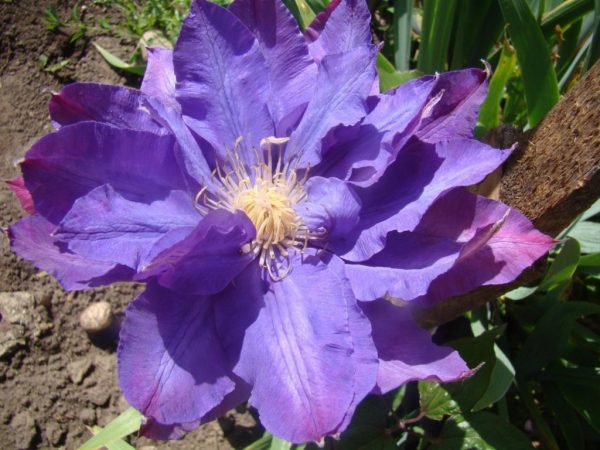
Clematis vivian pennell
Description of the variety
The plant belongs to moderately growing varieties with an early flowering period. It blooms 2 times a year: from May to June and in August. Shoots are long, reaching 2-3 m. Belongs to the large-flowered species.
Description of flowers Vivian Pennel:
- inflorescences are large, densely located;
- the buds consist of many pointed petals of various purple hues;
- flowers are densely double, bright, on annual shoots of lavender-blue color, during the re-flowering period - purple-purple, diameter - from 15 to 20 cm.
A feature of the plant is a rich variety of shades, depending on natural factors.
Landing features
Like any plant, clematis has its own planting characteristics. It is necessary to comply with the landing dates, correctly select and prepare a place for culture, planting material, and correctly implement the planting technology.
Timing
Plants with a closed type of root system can be planted from early spring to late autumn. Clematis is best planted:
- in spring - in April;
- in the fall - in August.
It should be borne in mind that the appearance of flowers in the current year gives only a spring planting. Planting in other months is acceptable, but it significantly reduces the likelihood of inflorescence forming in the same year.
Seat selection
The flower loves to grow in sunny places protected from strong winds, because under the influence of the wind, leaves fall abundantly, the appearance and condition of the vine deteriorates.
Suitable types of soil: sandy loam, sandy, loam - they have good drainage properties, there is no stagnation of water in them in the spring.
If the groundwater is too close to the site, it is necessary to remove excess moisture using drainage. For this purpose, you can put on the bottom of the hole: pebbles (with a layer of about 2 cm); wood ash; humus or other organic matter; lime, etc.
Despite the love of clematis for sunny places, it is necessary that the lower part and the root system are located in the shade.
Information: when planting plants with a closed root system, the prepared hole in volume should be larger than the pot in which the culture grew.
Preparation of planting material
In order for clematis to please the owner with their appearance, it is important to choose the planting material correctly.
To do this, purchase goods in special nurseries - this way you will reduce the likelihood of the death of the plant or the purchase of a flower of another variety.
Choose 2-year-old seedlings grown from cuttings and adapted to the terrain and climatic conditions. They should have at least 3-4 strong and resilient roots.
For vines without containers, carefully inspect the root system and leaves: make sure there are no pests, traces of disease and other damage.
Tip: Vivienne clematis do not tolerate frequent transplants, they need to be planted in a permanent place immediately after purchase.
Landing technology
The technology of planting clematis is classic:
- dig a hole;
- place the drainage material on the bottom with a layer of about 2 cm;
- mix the excavated soil with fertilizer;
- remove the seedling from the container, being careful not to damage the root system;
- place the plant in the center of the hole;
- cover the hole with earth;
- slightly deepen the root collar;
- Spill plenty of soil around the planted plant.
The distance between the holes is at least 0.6 m.
Recommendation: clematis get longer and gain weight every year, so set up supports for them. It can be lattices made of wood, tightly stretched strong fishing line.
Care
In addition to properly planting clematis, proper plant care is equally important. They need to be watered and fed in a timely manner, and also to know if there is a need for loosening and mulching, pruning, shelter for the winter.
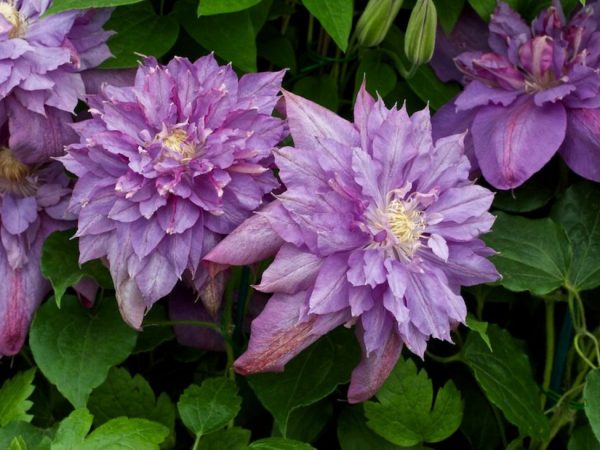
Clematis Vivian Pennel description
Top dressing
Meals are served at least 4 times per season. The plant is pre-watered:
- Complete mineral fertilizer with trace elements (20-40 g per bucket of water).
- Mullein. Dilute in water in a ratio of 1:10 and allow to ferment.
Organic and mineral dressings alternate. In the summer months, flowers are watered monthly with a solution of boric acid (1-2 g of the product is taken for 10 liters of water) and potassium permanganate (from 2-3 g per bucket of water).
The leaves are sprayed with a solution of urea at the rate of ½ tablespoon of urea per bucket of water. Young clematis require the most attention for the first 3 years.
In spring or autumn, they are fed with 1 bucket of humus with the addition of:
- potash fertilizer - 1 handful;
- phosphorus fertilizer - 1 handful;
- wood ash - 1 handful.
Every 2 weeks, liquid fertilizing is applied in small doses.
Loosening and mulching
Clematis do not need frequent loosening. They are loosened well after planting. Then the existing weeds are removed.
After the procedure, the land can be mulched:
- peat; rotted manure (in regions with a cold climate);
- sawdust, tree bark (in the southern regions).
Important: clematis mulching is carried out in order to avoid overheating or excessive dryness of the soil.
Watering
The flower does not like both lack and excess of moisture. In this regard, it is necessary to constantly monitor the level of soil moisture.
Immediately after planting, the plant is watered with copious amounts of water. For the next week, the procedure is carried out daily.
Further, watering is carried out periodically, avoiding flooding and trying not to get a stream of water into the center of the bush.
Pruning
Cutting group: 2nd (weak). Only dead shoots are completely removed.
In the fall, in front of the shelter, a bush of 4-8 shoots is thoroughly cleaned of leaves and cut to a height of at least 50 cm.
In the spring, inflorescences and flowers are formed on last year's, overwintered shoots. In late summer and early autumn - on new shoots that have appeared this year.
Tip: to achieve a more lush flowering of clematis, cut it obliquely at a distance of 7 mm from the buds.
Shelter for the winter
Vines are sheltered only in dry weather, when a constant temperature regime is established up to -7 ° C. Otherwise, the root system will get wet, and the shoots will be overheated, which will lead to the death of the culture.
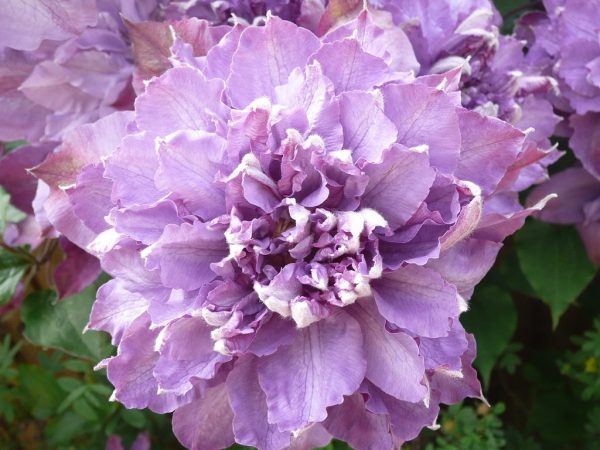
Clematis vyvyan pennell
Features of the procedure:
- In those areas where the snow cover is always present and lays down evenly, it is enough just to bend the shoots to the ground;
- In areas where there are thaws in winter, clematis is covered with peat and sawdust on top, then covered with a covering material to prevent the kidneys from freezing;
- Young shoots should be covered with a pot on top, sprinkled with foliage and straw, and then covered with spruce branches and cellophane wrap. For adults, use a wooden box.
The easiest way: spread spruce branches on the soil, bend the vines onto it, cover it again with spruce branches from above. This method protects against rodents, caking, disease infestation.
Reproduction
Large-flowered vyvyan pennell clematis are not propagated by seeds due to the fact that flowers grown in this way do not carry the properties and characteristics of the maternal clematis variety. They are propagated vegetatively: by layering, cuttings, dividing the bush.
Layers
An easy-to-use method that preserves the decorative appearance of the culture.
In the spring or autumn period:
- grooves are digged from the bush with a depth of 5 to 10 cm;
- side branches are placed in them;
- fix them with wire staples;
- sprinkle with peat and earth on top.
A year later, the rooted layers are separated from the main flower and planted on their own.
Information: the disadvantages of the method of reproduction of clematis by layering include the risk of infection with diseases that are present in the mother bush.
Cuttings
Cuttings must be cut from plants that are less than 5 years old. It must have at least 1 internode and 2 developed kidneys.
Nodes with buds will not work because they usually either lack vegetative buds or are poorly developed.
Cutting scheme: make a straight cut about 1.5-2 cm above the kidney and obliquely - 4-5 cm below the last kidney. In the presence of 2 internodes, the lower 2 leaves are torn off, and the upper ones are shortened by 2 times.
Places of cuts are powdered with Heteroauxin, Succinic acid or Kornevin. After that, the cuttings are planted at an angle, deepening by 5 mm, in a container filled with pre-disinfected boiling water or a saturated solution of potassium permanganate sand and peat (taken in a ratio of 1: 1 or 2: 1).
Planting is watered, covered with glass or film. In the room, it is necessary to maintain the temperature within +20 - + 22 ° C, water the seedlings well. By the end of summer, the cuttings should have a strong root system.
The second rooting option:
- tie several cuttings into a bunch;
- place them in a dark glass container filled with soft water (preferably rainwater), with a few pieces of charcoal so that the bottom cuts barely touch the water;
- place in a bright room without direct sunlight and a temperature of + 20-25 ° C.
After about 2 months, roots will appear. Transplant seedlings that have reached a height of 3 cm in separate containers.
By dividing the bush
A 5-6 year old bush is dug up in spring or autumn. Neatly divided into several parts, each planted separately.
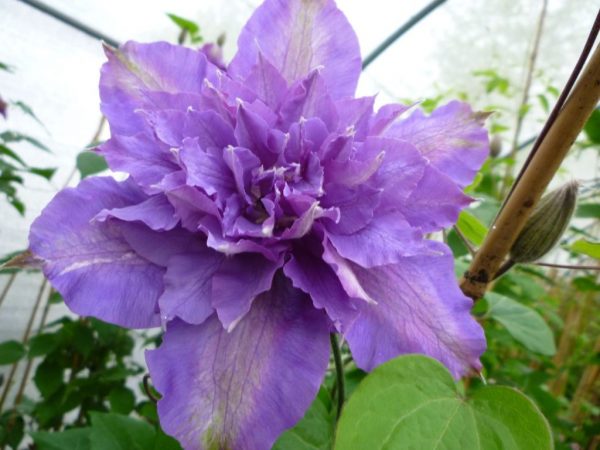
Clematis vivian pennel description and photo
Clematis propagated in this way begins to bloom very quickly. However, there is a risk of severely damaging the root system when digging.
Recommendation: if the bush is too large and difficult to dig out, dig it in only on one side and use a shovel to separate the flower share.
Diseases and pests
The most common in clematis are fungal diseases: wilting (wilt) and fusarium.
Reason for appearance: waterlogging, high humidity.
Methods of struggle and treatment: pruning the affected parts of the flower, burning them, spraying the bush and soil with foundationol at the rate of 20 g per bucket of water, copper or iron vitriol, Bordeaux liquid (1%).
The plant can be attacked by polyphagous pests that affect both the aerial part and the roots. It must be protected from rodents, spider mites, slugs, snails, aphids.
Preventive measures:
- the correct landing site;
- compliance with all agrotechnical procedures;
- planting next to a flower of marigolds or marigolds, which will create a shadow for the base of the shoots, scare off rodents and insects with their smell (these plants are removed in autumn).
Use in landscape design
Due to the ability of clematis to grow strongly, they are often used in landscape design.
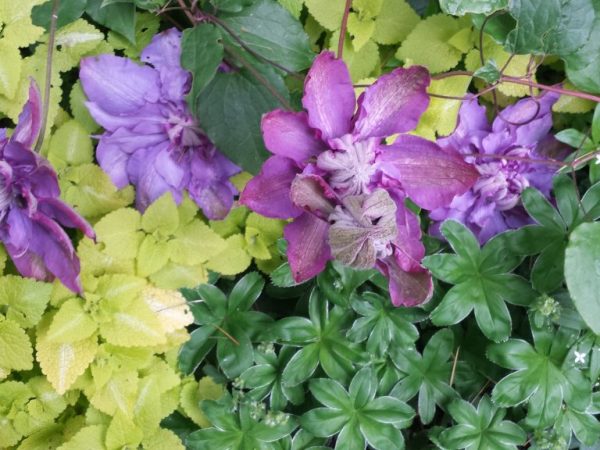
Clematis vivien pennel care
List of applications: for vertical decoration of walls of houses, terraces, gazebos, arches, columns, fences; decorating other shrubs and trees and for creating frame compositions.
Testimonials
According to gardeners, large clematis flowers create an amazing, magical atmosphere in the garden. They like the variety of colors, the possibility of flowering 2 times a year. They are easy enough to propagate and easy to care for.
The plant with the original name Vivian Pennel will be a chic decoration of any site. Its sophisticated appearance will leave no one indifferent.

